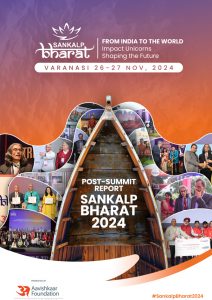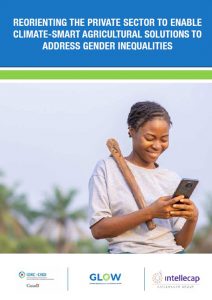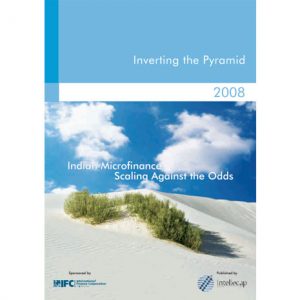TRENDING
-
SSAGA – Benefitting small-scale farmers by fostering innovations and collaboration across the Global South
Published: March, 2025 -
Sankalp Bharat 2024-Post Summit Report
Published: March, 2025 -
Reorienting The Private Sector To Enable Climate-smart Agricultural Solutions To Address Gender Inequalities
Published: February, 2025
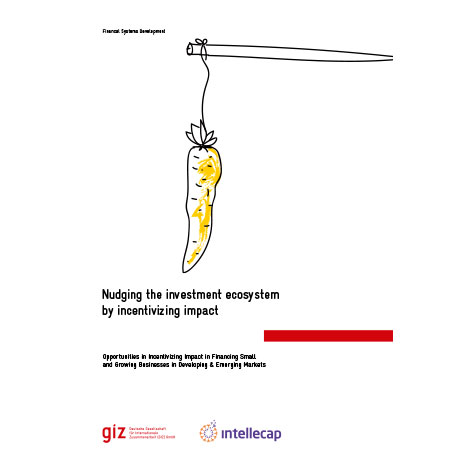
Nudging The Investment Ecosystem By Incentivizing Impact
PUBLISHED: June, 2018
Opportunities in Incentivizing Impact in Financing Small and Growing Businesses in Developing & Emerging Markets
This paper is a summary of fresh ideas on how to channel more capital into impact investing and incentivize impact creation. Building on insights generated by experts at the BMZ hosted conference Financing Global Development – Leveraging Impact Investing for the SDGs, the paper furthers the conversation on Impact Measurement and Management, IMM 2.0, through brainstorming practical ideas and viewpoints in the impact investing value chain: those who provide capital, those who manage it, and those who receive it. This included close to 50 stakeholders, including fund managers, DFIs, intermediaries, entrepreneurs, governments, CSOs and others.
The discussion, conducted in the form of a ‘design lab’ by Deutsche Gesellschaft für Internationale Zusammenarbeit (GIZ) GmbH, Intellecap, and the Swiss Agency for Development and Cooperation (SDC), aims to start a conversation on how to maximize impact by channeling capital into small and growing businesses (SGBs) as a way to expedite achievement of SDGs (Sustainable Development Goals). During the session, industry leaders like FMO, Vox Capital, and Roots of Impact had shared case studies of good practices in incentivizing impact along the investment chain. This formed the basis of brainstorming on development of new ideas on innovative instruments that could nudge the ecosystem towards more actively pursuing and scaling impact.
The result is an analysis of the barriers in the impact investment value chain highlighted during the stakeholder conversations, and key insights on how to overcome them (for example, the need for transparency, standardization, leadership, etc.). In addition, the workshop collated a list of potential ‘wild ideas’ to like impact currency, impact rewards, impact index, online market places for impact auctioning, and a give-back distribution impact support system, designed to incentivize increased levels of investment along the value chain. The practical approaches suggested by stakeholders fit well with the existing impact measurement and monitoring frameworks like GIIN’s IRIS and Intellecap’s PRISM and hold the potential to guide impact capital more efficiently by leveraging good practices.

The Financial Lives of Government Employees – Potential of Digital Finance in Sierra Leone
PUBLISHED: July, 2018
This report documents findings from research on the financial lives of government employees in Sierra Leone, commissioned by the Government to People Payments Project – Building Digital Ecosystem funded by USAID. Intellecap supported UNCDF, Government of Sierra Leone and Bank of Sierra Leone for conducting the research.
There are 80,000 government employees in Sierra Leone who receive salaries digitally in their bank accounts. Insights about their financial lives can help build a viable business case for DFS to expand access to a wide range of financial services for underserved communities in Sierra Leone. Such insights can inform strategies and use cases that the UNCDF and the Government of Sierra Leone can develop to promote DFS in the country. The National Strategy for Financial Inclusion 2017 – 2020 also refers to the need to identify and digitize use cases that will lead to habitual usage, and achieve Sierra Leone’s commitments to the ‘Better Than Cash Alliance’.
Recognizing the need and opportunity, UNCDF supported the Financial Lives Survey of government employees who receive their salaries digitally in Sierra Leone. Intellecap designed the survey to understand how government employees utilize salaries transferred into their bank accounts, their awareness of and access to DFS, avenues to use them and their perceptions about financial services and digital financial transactions. This report contains insights from the survey about potential customers of DFS and recommendations on use cases that could be piloted as an initial step to improve DFS adoption in Sierra Leone.
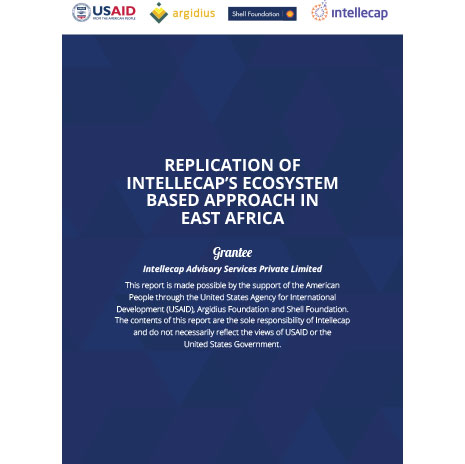
Replication of Intellecap’s Ecosystem Based Approach in East Africa
PUBLISHED: July, 2018
Intellecap has sought to replicate its ecosystem-based approach to East Africa by bringing
together capital, knowledge and networks to support SGBs at two levels: (i) provide direct support
to SGBs in the form of acceleration, fund-raising, technical assistance, innovation transfer, and
market linkages, and (ii) discover and engage critical ecosystem players such as corporations
(both local and international), accelerators, other development sector players in supporting SGBs.
In the three-year period since the launch of our initiative to replicate our ecosystem-based
approach for accelerating entrepreneurship support to SGBs in East Africa, we have received
generous support not only from our funders, but also from a number of local and international stakeholders such as development institutions, private sector entities, and industry associations.
Over the last year, we have replicated our advocacy platform (Sankalp), angel investment network
(I3N) advisory services (consulting & investment banking), virtual incubation platform
(StartupWave) and impact measurement platform (PRISM) as envisaged at the beginning of our
programmatic support. The development and adaptation of StartupWave for East Africa has
resulted in over 450 sign-ups for our early stage enterprise support activities and partnerships with
over 30 incubators / accelerators. Similarly, PRISM, our impact measurement platform, has
garnered interest from a wide variety of players to measure the impact of their programs.
All Publications
-
Flows: Filling up the Base of the Pyramid – Business and Finance Solutions to Scale up Water Access for India’s poor
PUBLISHED: December, 2009Tags: Financial Services, HealthRegion: AsiaREAD MORE -
Inverting the Pyramid: Indian Microfinance Coming of Age
PUBLISHED: June, 2009Tags: MicrofinanceREAD MORE
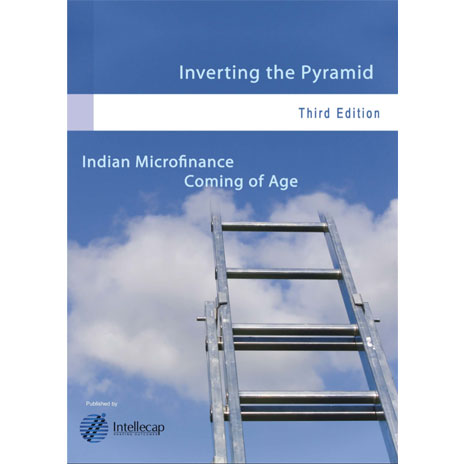
Inverting the Pyramid – 2010
PUBLISHED: March, 2010
The Inverting the Pyramid series was launched by Intellecap in 2007 as an attempt to capture the growth of the microfinance industry in India on an annual basis and track the efforts made, success achieved and challenges that remain. Every year, it maps the microfinance landscape in India, identifies key highlights of the year, explores strides made in addressing the huge demand-supply gap that exists and analyzes the performance of MFIs. Further, it identifies key drivers for future growth and sustainability of this industry, its capital needs and its risks and priorities in the short to medium term.
The 2007 edition titled The Changing Face of Indian Microfinance captured Indian microfinance as a dynamic industry on the move. In 2008, Indian Microfinance: Scaling Against the Odds captured a resilient industry maintaining scale and asset quality amidst a turbulent financing landscape.
The 2009 report, Indian Microfinance: Coming of Age finds India at the centre of global attention, the most closely watched microfinance market in the world. While its large unbanked population is a significant contributor to this attention, its fast growth, high investor interest, planned IPOs and continued strong operational and financial performance have also piqued the interest of investors, thought leaders, media and the public alike.
Chapter one explores five key questions on the minds of industry observers as heard in global microfinance conversations. Topics covered range from the frenzied pace of growth of Indian MFIs to whether they are losing their social orientation with increasing commercialisation to governance and valuations.
While the India tops the global list of recipients of commercial capital for microfinance, the number of people still financially excluded runs into millions. Chapter two puts this dichotomy in perspective by estimating the unmet demand for microfinance and related products and the extent of current supply in the Indian market. Further, this chapter examines emerging products and services being offered by MFIs and gauges the potential for their expansion.
Chapter three captures an Indian microfinance market whose structure and dynamics are vastly different from what they were two years ago. The industry emerged from the financial crisis more consolidated – the market that was made of numerous, small and medium sized, non-profit players gave way to one dominated by fewer large commercial players that are successfully attracting equity and debt capital, human resources and clients at a fast rate.
The traditional tier classification of MFIs based on their portfolio size fails to capture the emerging dynamics and activity in the market which led us to create an alternate classification that accounts for growth rates. Using this method, we identify three major classes of MFIs: the Leaders, the Moderates and the Young Turks. In chapter three, we examine the growth and performance of each of these segments in greater detail. Towards this, Intellecap uses financial and operational data of a sample of 29 MFIs in the country that constitute 80% of the market by portfolio outstanding.
Chapter four then explores where the growth capital for the industry is coming from, who it is going to, the outlook on exits for equity investors and the increasing sophistication in financial instruments used in the industry. We find that hedge funds, high net-worth individuals and blue chip private equity players have entered the market amongst others, and public sector banks have increased their exposure contributing a fourth of the debt capital needs of the sector.
In chapter five we examine the impact of the financial crisis of 2007-2008 on the clients of Indian MFIs. We find that home-based urban workers were hardest hit, and disposable incomes fell overall, as did savings, coupled with increased difficulty in accessing credit.
Finally, in chapter six, we look at how the industry could evolve in the near future. The section covers how recent regulation on business correspondents could change the microfinance landscape and projects debt and equity capital needs of the market for the next five years.
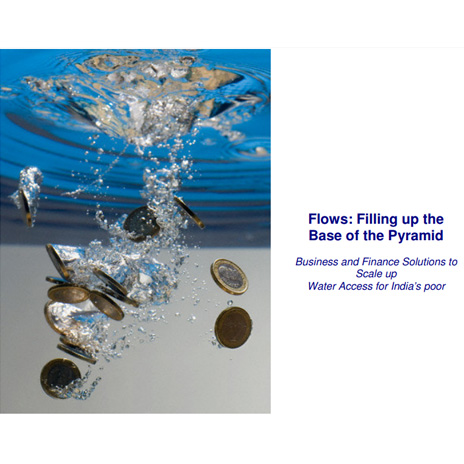
Flows: Filling up the Base of the Pyramid – Business and Finance Solutions to Scale up Water Access for India’s poor
PUBLISHED: December, 2009
The Dutch development finance company FMO, the Indian development finance
consultancy Intellecap and the Indo-Dutch social investment firm Goodwell announce the
launch of a joint program to build scaleable business and finance solutions to meet the
huge unmet water and sanitation needs of low income households, farmers and
communities in India. Suitable finance and business solutions are often identified as
missing inputs in creating large scale access to safe drinking water and sanitation,
irrigation and water management. In the next 2-3 years, the Flows program will select
proven water solutions and develop and implement demand-driven, financially sustainable,
replicable and scalable businesses around these solutions. The Flows program will draw
upon global best practices and leverage strategic partnerships across supply chains in the
water, sanitation and finance sectors.
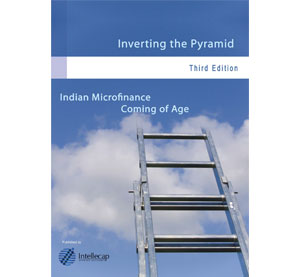
Inverting the Pyramid: Indian Microfinance Coming of Age
PUBLISHED: June, 2009
The Inverting the Pyramid series was launched by Intellecap in 2007 as an attempt to capture the growth of the microfinance industry in India on an annual basis and track the efforts made, success achieved and challenges that remain. every year, it maps the microfinance landscape in India, identifies key highlights of the year, explores strides made in addressing the huge demand-supply gap that exists and analyzes the performance of MFIs. Further, it identifies key drivers for future growth and sustainability of this industry, its capital needs and its risks and priorities in the short to medium term.
The 2007 edition titled The Changing Face of Indian Microfinance captured Indian microfinance as a dynamic industry on the move. In 2008, Indian Microfinance: Scaling Against the Odds captured a resilient industry maintaining scale and asset quality amidst a turbulent financing landscape.
The 2009 report, Indian Microfinance: Coming of Age finds India at the centre of global attention, the most closely watched microfinance market in the world. While its large unbanked population is a significant contributor to this attention, its fast growth, high investor interest, planned IPos and continued strong operational and financial performance have also piqued the interest of investors, thought leaders, media and the public alike.
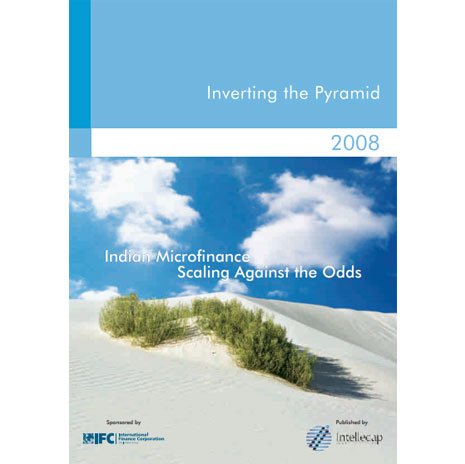
Inverting the Pyramid – 2008
PUBLISHED: March, 2008
India is a huge market for microfinance – within a fast growing economy, it has more than 400 million poor’ seeking an opportunity to reduce their vulnerabilities, create assets and ensure income security. For many, microfinance forms the first stepping stone of this opportunity.
Microfinance Institutions (MFIs) in India have emerged as effective financial intermediaries offering a middle path – an alternative to the inaccessible formal financial institutions and the exploitative money lenders. With early stage donor funding and growth capital from banks, they have demonstrated commendable scale, sustainability and impacts.
However, to reach out to the majority of un-banked millions, this industry needs much higher sums of capital to help it scale up rapidly and widen its range of services On the other hand, there is substantial capital present across the globe in search of opportunities that really make a difference to the world’s poor. While microfinance is one such opportunity popular among capital providers, it is critical to channel this capital effectively to sustainable interventions working closely with the poor. The available capital takes the shape of a pyramid with a few risk taking capital providers at the peak and many more at the base The available opportunities also take the shape of a pyramid with a few large MFIs at the peak and many smaller ones at the base. While capital has started to flow from a few risk taking capital providers in the first pyramid into some of the large MFIs in the latter, a clear challenge is to open the aperture wider and create more partnerships between capital providers and MFIs.
The Inverting the Pyramid series by Intellecap was launched in 2007 as an attempt to capture this process on an annual basis and track the efforts made, successes gained and challenges that remain. Every year, it maps the microfinance landscape in India, identifies the key highlights of the year, explores strides made in addressing the huge demand-supply gap that exists in the market and analyzes the financial performance of MFIs, one of the key providers of microfinance in India. Further, it identifies the key drivers for future growth and sustainability of this industry growth, capital needs, risks and priorities in the short to medium term.
To analyze the industry performance, Inverting the Pyramid uses data from a sample of 70 MFIs in India. It draws insights from over 30 stakeholders in the industry to understand the dominant trends, future outlook, concerns and priorities.
To analyze the industry performance, Inverting the Pyramid uses data from a sample of 70 MFIs in India. It draws insights from over 30 stakeholders in the industry to understand the dominant trends, future outlook, concerns and priorities.
The 2007 edition entitled The Changing Face of Indian Microfinance captured Indian microfinance as a dynamic industry on the move, changing its ambitions and scale of operations rapidly. This year, Indian Microfinance Scaling Against the Odds presents a resilient industry maintaining its scale and asset quality amidst a turbulent financing landscape.
Questions or comments on this publication may be addressed to publications@intellecap.net.
Reports & Policies
Our Impact Map

Sign up for our newsletter
© Copyright 2018 Intellecap Advisory Services Pvt. Ltd. - All Rights Reserved




